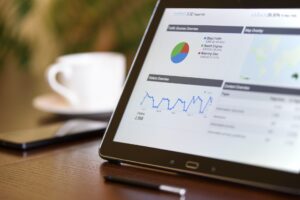Over the past year, we have seen a complete 180 in how companies utilize digital marketing. No matter if you are a mom-and-pop shop or a fortune 500, the Coronavirus has made some lasting impact on your business. For many, this meant closing their in-person offerings. This massive migration to work-from-home also meant a massive migration to the digital realm for marketing. Today we cover the COVID19 Impact on Marketing and how we responded.
Larger companies were placed in the position of having millions of dollars freed up from canceled trade shows. Smaller shops needed to figure out a way to reach their audience without the appeal of any in-person marketing or events. No matter what size company you were, there was suddenly a huge emphasis on digital marketing and reaching consumers who were now much more digital. For companies to take full advantage of people working-from-home, they needed to utilize different channels that encompass digital marketing.
There is currently a massive influx of marketing dollars being spent in the digital marketing space, making it important that businesses know accurate information about the different channels. Typically, companies are quick to point to some key digital assets and social media, but it takes a lot more to build a strong web presence truly.
Today, I will dive into PESO (Paid, Earned, Shared, Owned) as it pertains to digital marketing. PESO stands for the 4 types of ways you can build traffic, trust, and conversions to your business. For your business to be successful long after the pandemic ends, you will want to make sure you know the 4 different media channels.
Paid Media Overview
The fastest way to get people to your website, buying your product is to pay for these people to come through various advertising channels. Paid Media extends across the internet and is interwoven into nearly every website you visit.
Ads you see on Facebook? Paid Media. Banner ads on websites? Paid Media. Ads that seem to follow you wherever you search? You guessed it, that’s also Paid Media.
Paid Media can be defined as any digital marketplace that allows you to create ads and copy and then allows you to pay to get your content in front of a specific audience.
Paid Media Platforms and COVID19 Impact on Marketing
There are website-specific platforms you can run ads from for social media websites like Facebook, Instagram, LinkedIn, and Twitter. Each of these platforms has a specific dashboard and process that creates, runs, and tracks consumers as they go through their purchasing journey.
If you want to advertise on Google or other popular websites, you can utilize Google Ads. This gives you the option to advertise across Google search results, Youtube, and Google’s thousands of partner websites. We even covered this topic in a recent webinar. There is also the option of running campaigns across other search engines like Bing or Yahoo. These platforms are worthwhile to look into because of their lower costs per click and conversion; however, these platforms also tend to have less overall traffic.

media
Programmatic advertising is the last type of paid advertising I want to focus on. This encompasses the top websites, digital radio station programs, online digital programming, and more. If you are looking to reach specific target markets while consuming digital content, this is the place to be. According to Nielson, digital media consumption has increased over 60% since the start of COVID-19. This means that these targeted ads are more likely to hit the exact audience you want when working with an agency that provides programmatic marketing options like V Digital Services.
When working within programmatic advertising networks, you will want to ensure the data you are using is clean and full of leads likely to convert. Clean data comes from reliable sources like The Trade Desk (TTD), which can serve these ads to all the top websites and streaming platforms. No matter if it is video, audio, or banners, there is space to place ads within the programmatic advertising realm.
Earned Media
In all marketing earned media is typically the most sought-after form of marketing. earned media are publications or websites that create content promoting your brand and direct people to your website.
Great examples of this will be if your website is featured in a news article or “best of” article. The more related the article is to your website, the bigger the impact the link will make on your website. Having different sites link back to your website tells search engines to start ranking your website higher, positively affecting your SEO score. Typically larger sites make a bigger impact when they link to you both with immediate traffic and overall SEO value.
Your clients can review other forms of earned media. More than ever, people trust other consumers and consider reviews before utilizing a service or buying a product. Reviews on social media pages like Facebook and LinkedIn and Google My Business reviews are key to maintaining a good reputation.
Shared Media
Sharing is caring. That rule definitely still applies when it comes to content on the internet. Shared media refers to shares you get on your organic content on social media channels like Facebook, Linked In, Twitter, Instagram, and Pinterest. and shared media was particularly effective in combating COVID19 Impact on Marketing.

together
The best way to grow engagement naturally is to have your audience share your content. This is both free and extremely effective. Social media channels typically limit the amount of views business posts get to only about 10-15% of the audience unless you pay to boost or promote your posts.
Great ways to encourage your audience to share your content is to create engaging content or incentive your consumers. Engaging consumers would be asking for opinions and creating posts that invoke responses. With this strategy, it is also important to keep engaged with your users. Otherwise, conversations feel one-sided. Alternatively, you can create a giveaway or contest posts that count shares as entries. This tactic is a surefire way to get people to share your content.
Owned Media
Much like the title, owned media refers to assets you or your company owns. Owned media can consist of everything from marketing lists to websites to actual written content. Anything directly controlled by yourself is going to fall into the owned media segment.
As your company grows, your owned media strategy should grow as well. Because once you are a trusted source in your field, you can sell space on your website to interested parties within your industry. Alternatively, you can grow as a trusted source through reliable blog content and written work. Having a consistent message and brand across your owned media can help consumers understand your brand.
COVID19 Impact on Marketing
Now that you have gone through PESO for digital marketing, you are ready to ensure your business is successful in the evermore digital world. For more information on any of the media channels, email [email protected], or submit a contact form. Having a well-balanced digital marketing strategy is key to success in a COVID-19 world.


